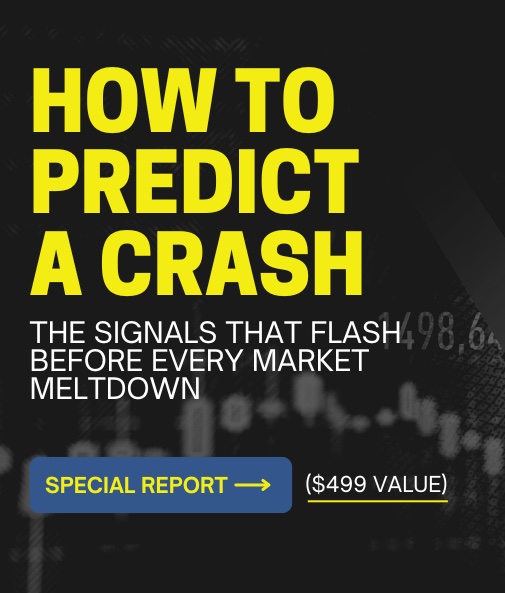THE ONLY REPORT INVESTORS NEED TO KNOW WHEN TO GET OUT OF STOCKS
LISTEN TO OUR PODCAST.
GRAHAM'S NEW BOOK WAS THE #1 NEW RELEASE IN FOUR CATEGORIES ON AMAZON
HOT TOPICS.
- 2008
- bail-ins
- bear market
- Bernanke
- big banks
- bond bubble
- bonds
- BOVESPA
- Carry Tax
- cash ban
- central banks
- China
- collapse
- contraction
- crash
- crisis
- debt
- debt crisis
- debt implosion
- deflation
- Derivatives
- economic collapse
- Federal Reserve
- inflation
- interest rates
- investing
- Jp MOrgan
- meltdown
- NIRP
- Operation Twist
- PboC
- Private wealth
- QE
- recession
- S&P 500
- slowdown
- stock market crash
- stocks
- TBTFs
- the Fed
- the market
- US Dollar
- War on cash
- Yellen
- ZIRP
Category Archives: stock collapse?
Is the Fed TRYING to Trigger a Debt Crisis?
By Graham Summers, MBA | Chief Market Strategist The Fed is in the political crosshairs. As I outlined previously, there is ample evidence that the Fed, particularly Fed Chair Jerome Powell acts in a highly political manner. This runs contrary … Continue reading
Posted in Banana Republic Corruption, Bank Crisis, Central Bank Insanity, stock collapse?
Comments Off on Is the Fed TRYING to Trigger a Debt Crisis?
Buckle Up: The Jobs Market Just Rolled Over
By Graham Summers, MBA | Chief Market Strategist As I keep emphasizing, the labor market is cracking. Yesterday, ADP released its employment numbers for June. And they were UGLY. According to the data, the economy LOST 33,000 jobs last month. … Continue reading
Posted in stock collapse?
Comments Off on Buckle Up: The Jobs Market Just Rolled Over
The Powell Fed is Going to Trigger Another Crisis
By Graham Summers, MBA | Chief Market Strategist Fed Chair Jerome Powell has no idea what he’s doing. I’m not saying this for dramatic effect. Powell’s ignorance of basic macroeconomics was on stark display in his testimony before Congress earlier … Continue reading
Posted in Central Bank Insanity, stock collapse?
Comments Off on The Powell Fed is Going to Trigger Another Crisis
I Sincerely Hope You Took Advantage of This!
By Graham Summers, MBA | Chief Market Strategist Two days ago, I wrote an article titled “Are the Markets Signaling a Peace Dividend?” Fast forward to today, and something of a cease fire is in place, though both Israel and … Continue reading
Posted in Geopolitics, stock collapse?, The Markets
Comments Off on I Sincerely Hope You Took Advantage of This!
Market Update: Things Are Heading the WRONG Direction
By Graham Summers, MBA | Chief Market Strategist Yesterday was a whirlwind of news (some fake) concerning the conflict between Israel and Iran. Among the announcements: At this point, trying to predict what comes next is impossible, particularly when you … Continue reading
Posted in Geopolitics, stock collapse?
Comments Off on Market Update: Things Are Heading the WRONG Direction
The Everything Bubble Will Burst in 2026
By Graham Summers, MBA | Chief Market Strategist We are officially going on record with a startling prediction. That prediction? The Everything Bubble will burst in 2026. The Trump administration came into office proclaiming that it was a champion of … Continue reading
Posted in Debt Bomb, stock collapse?, The Everything Bubble
Comments Off on The Everything Bubble Will Burst in 2026
A Debt Crisis is Coming… The Time to Prepare is NOW!
By Graham Summers, MBA | Chief Market Strategist On Friday after the market’s close, Moody’s downgraded the U.S.’s credit rating from AAA to Aa1. While the timing of this announcement is suspect (where was Moody’s during the last four years … Continue reading
Posted in stock collapse?
Comments Off on A Debt Crisis is Coming… The Time to Prepare is NOW!
Urgent Market Update: The U.S. Was Just Downgraded… a Bloodbath is Coming!
By Graham Summers, MBA | Chief Market Strategist Moody’s just downgraded the U.S.’s credit rating from AAA to Aa1. The markets will be opening sharply down on Monday. Anyone who chased the rally into the close on Friday last week … Continue reading
Posted in stock collapse?
Comments Off on Urgent Market Update: The U.S. Was Just Downgraded… a Bloodbath is Coming!
Is the Stock Market About to Crash?
“Are the markets about to reverse course and crash?” This is the #1 question on investors’ minds today. The stock market has just staged one of its most spectacular “V-shaped” recoveries in history. And many investors are wondering if the … Continue reading
Posted in Bank Crisis, Central Bank Insanity, stock collapse?, The Markets
Comments Off on Is the Stock Market About to Crash?
Is Dr. Paul’s Dark Prophecy About to Finally Unfold?
By Graham Summers, MBA | Chief Market Strategist I’m a big fan of Dr Ron Paul. For years, Dr Paul has proclaimed that the U.S. government should NOT be engaged in reckless spending, that U.S. debt levels were reaching the … Continue reading
Posted in Central Bank Insanity, Debt Bomb, stock collapse?
Comments Off on Is Dr. Paul’s Dark Prophecy About to Finally Unfold?
Is the Fed Trying to Crash Stocks?
By Graham Summers, MBA | Chief Market Strategist The #1 mandate for the Fed is to maintain financial stability. That is literally the Fed’s job. It’s supposedly why the Fed was created in 1913. The stock market just experienced one … Continue reading
Posted in It IS different this time., stock collapse?, The Dollar, The Economy, The Everything Bubble, The Markets
Comments Off on Is the Fed Trying to Crash Stocks?
The Trade Wars Just Claimed Their First Major Victim
By Graham Summers, MBA | Chief Market Strategist The trade wars just claimed their first victim: Nvidia (NVDA). NVDA is one of the most important companies in the stock market. The reason for this is that NVDA produces the chips/ … Continue reading
Posted in Recession Watch, stock collapse?
Comments Off on The Trade Wars Just Claimed Their First Major Victim
If They’re Not Careful, the Markets Will CRASH
By Graham Summers, MBA | Chief Market Strategist The Trump administration has a “messaging” problem. Over the weekend, stocks erupted higher when it was announced that the U.S. would provide exemptions from new tariffs for phones, computers and chips from … Continue reading
Posted in stock collapse?
Comments Off on If They’re Not Careful, the Markets Will CRASH
What Happens if China Dumps Its Treasury Holdings?
By Graham Summers, MBA | Chief Market Strategist A very strange thing is happening in the markets. Historically, when the stock market collapses, money flees stocks and floods into U.S. Treasuries. The reason for this is that Treasuries are considered … Continue reading
Posted in Bank Crisis, Debt Bomb, stock collapse?, Trade Wars
Comments Off on What Happens if China Dumps Its Treasury Holdings?
By Graham Summers, MBA | Chief Market Strategist The stock market is in a free-fall as Wall Street realizes that the Trump administration is serious about restructuring the global economy. For decades, the dominant theme in trade and macroeconomics was … Continue reading
April 4, 2025
Comments Off on These Are the Investments to Own to Survive This New Market
Did Trump Just “Liberate” Stocks From a Bull Market?
President Trump just unveiled the tariffs the U.S. will be placing on trading partners in the Rose Garden a few moments ago. It’s a YUUUUUUGE chart… and represents a tectonic shift in global trade. Get a Load of That YUGE … Continue reading
Posted in stock collapse?
Comments Off on Did Trump Just “Liberate” Stocks From a Bull Market?
Ok, Now This is SERIOUSLY Bad News For Stocks
By Graham Summers, MBA | Chief Market Strategist Today is “liberation day” according to the Trump administration. President Trump believes that introducing tariffs against the U.S.’s trading partners will make things “fair” and stop the U.S. from being “ripped off.” … Continue reading
Posted in stock collapse?
Comments Off on Ok, Now This is SERIOUSLY Bad News For Stocks
It’s Official… the Economy is Starting to Break
By Graham Summers, MBA | Chief Market Strategist I warned that the Fed was going to break something. Well, things are starting to break. The latest round of economic data was disastrous. Consumer confidence collapsed to its lowest reading since … Continue reading
Posted in Central Bank Insanity, stock collapse?
Comments Off on It’s Official… the Economy is Starting to Break
Since 1980, This Has Signaled The Lows Are In
By Graham Summers, MBA | Chief Market Strategist The S&P 500 has now performed back to back “90% up days”. A 90% up day is a day in which 90% or more of the stocks that comprise a stock market … Continue reading
Posted in It's a Bull Market, stock collapse?
Comments Off on Since 1980, This Has Signaled The Lows Are In
This is the Chart to Focus On This Week
By Graham Summers, MBA | Chief Market Strategist Finally some good news! On Friday, stocks experienced their largest single day gain of 2025. Friday was also a 90% up day: a day in which 90% of stock trading volume was … Continue reading
Posted in It's a Bull Market, stock collapse?
Comments Off on This is the Chart to Focus On This Week




